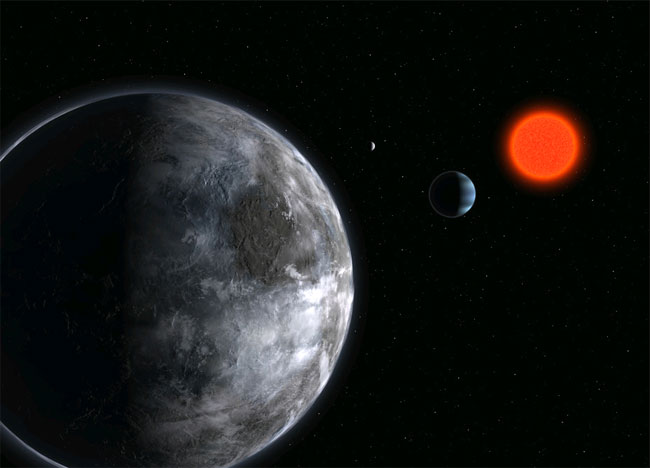Question: How Big Can Planets Get?
Answer: Here in the Solar System, we have three kinds of planets: the inner terrestrial planets, the gas giants, and the ice planets. Sadly, Pluto is no longer a planet, so we won’t deal with that here. We know how big our planets are, but how big can planets actually get in other Solar Systems. What are the biggest possible planets?
Let’s start with terrestrial planets, like our Earth. We’ll set the size of the Earth and 1 Earth radius, and the mass as 1 Earth mass. We’ve seen that terrestrial planets can get smaller, with Mars and Mercury, and astronomers have detected larger terrestrial planets orbiting other stars.
The largest known rocky planet is thought to be Gliese 436 c. This is probably a rocky world with about 5 Earth masses and 1.5 times our planet’s radius. Amazingly, this planet is thought to be within its star’s habitable zone.
What’s the largest possible rocky planet? For this I put in an email to Dr. Sean Raymond, a post doctoral researcher at the Center for Astrophysics and Space Astronomy (CASA) at the University of Colorado. Here’s what he had to say:
“The largest “terrestrial” planet is generally considered the one before you get too thick of an atmosphere, which happens at about 5-10 Earth masses (something like 2 Earth radii). Those planets are more Earth-like than Neptune-like.”
Gas giants, of course, can come much larger. Jupiter is 317 times more massive than Earth, and 11 times larger. You could fit 1,400 Earths inside Jupiter.
Thebiggest planet in the Universe (at the time of this writing) is TrES-4, which is located 1,400 light years away in the constellation Hercules. The planet has been measured to be 1.4 times the size of Jupiter, but it only has 0.84 times Jupiter’s mass. With such a low density, the media was calling TrES-4 the puffy planet.
And once again, how large can they get? Again, here’s Dr. Raymond:
“In terms of gaseous planets, once they reach 15 Jupiter masses or so there is enough pressure in the core to ignite deuterium fusion, so those are considered “brown dwarfs” rather than planets.”
What is the biggest planet in the Solar System?


Actually, according to that nonsense of a definition adopted by the IAU (you know, the same by which “sadly Pluto is no longer a planet”, as you put it), the answer to “how big can a planet get?” is, quite simply, “Jupiter”. And if the question was “how big can a terrestrial planet get”, the answer would be just as simple: “Earth”. ‘Cause under that marvel of a definition, there ain’t no planets outside the Solar System. Ain’t it cute?
15 Jupiter masses maybe the start of deuterium fusion, but the question asks how big – that means size, not mass. I believe that gas giants a few times more massive than jupiter become smaller in size as gravity compresses them till they are actually smaller than Jupiter. Likewise many red giants have quite moderate masses compared to their sizes. I’m unsure if this one has been answered properly.
Hi All
There’s been some recent work on the maximum diameters of terrestrial planets of different compositions – a paper by Marc Kuchner and colleagues received quite a bit of press attention as it was a NASA sponsored study, but its conclusions were much the same as similar work published.
The maximum radius differs depending on composition, but for rock/iron planets like Earth and Venus, the maximum radius is about 3 Earths – anything bigger and the core shrinks and becomes increasingly degenerate. So if an “earth” massed as much as Jupiter it would still be smaller than Neptune, and its surface gravity would be intense.
ok Jorge who told you that stupid lie that there is no planet outside our solar system
The 5 Earth mass planet in the habitable zone is around Gliese 581, not 436. The Earth is the largest solid body in the solar system, and that is why I used to be proud to live on the largest solid object; I hated any possible super-earths. Now, I am accepting. In our solar system, there is no ice planets known – only ice dwarf planets. If some of the large moons (like Ganymede) orbited the Sun directly, there would have been icy planets. Before, I used to think that icy planets should be counted as terrestrials because they also have a solid surface and are usually small, but now I realize that chemical composition matters too. What I am really excited about is finding extrasolar dwarf planets and extrasolar moons.
And by the way, if a fluid layer surrounding a central object is almost as thick, or thicker, than the size of the central body, it cannot be looked at as an atmosphere or ocean. An atmosphere is just some gas around a planet, and an ocean is just a liquid on the surface. If the layer is larger than the central object, it must be looked at as part of the object. Jupiter’s solid core only makes up the very central part, the rest is gas. The thickness of the gas layers together is much greater than the diamter of the core. Thus, those gas layers are not an atmosphere or ocean, they are already the planet’s body. Only Jupiter’s very outer layer is the atmosphere! The atmosphere is not a part of the planet, it is almost like separate material orbiting the planet, but the difference is that the atmosphere does not orbit.